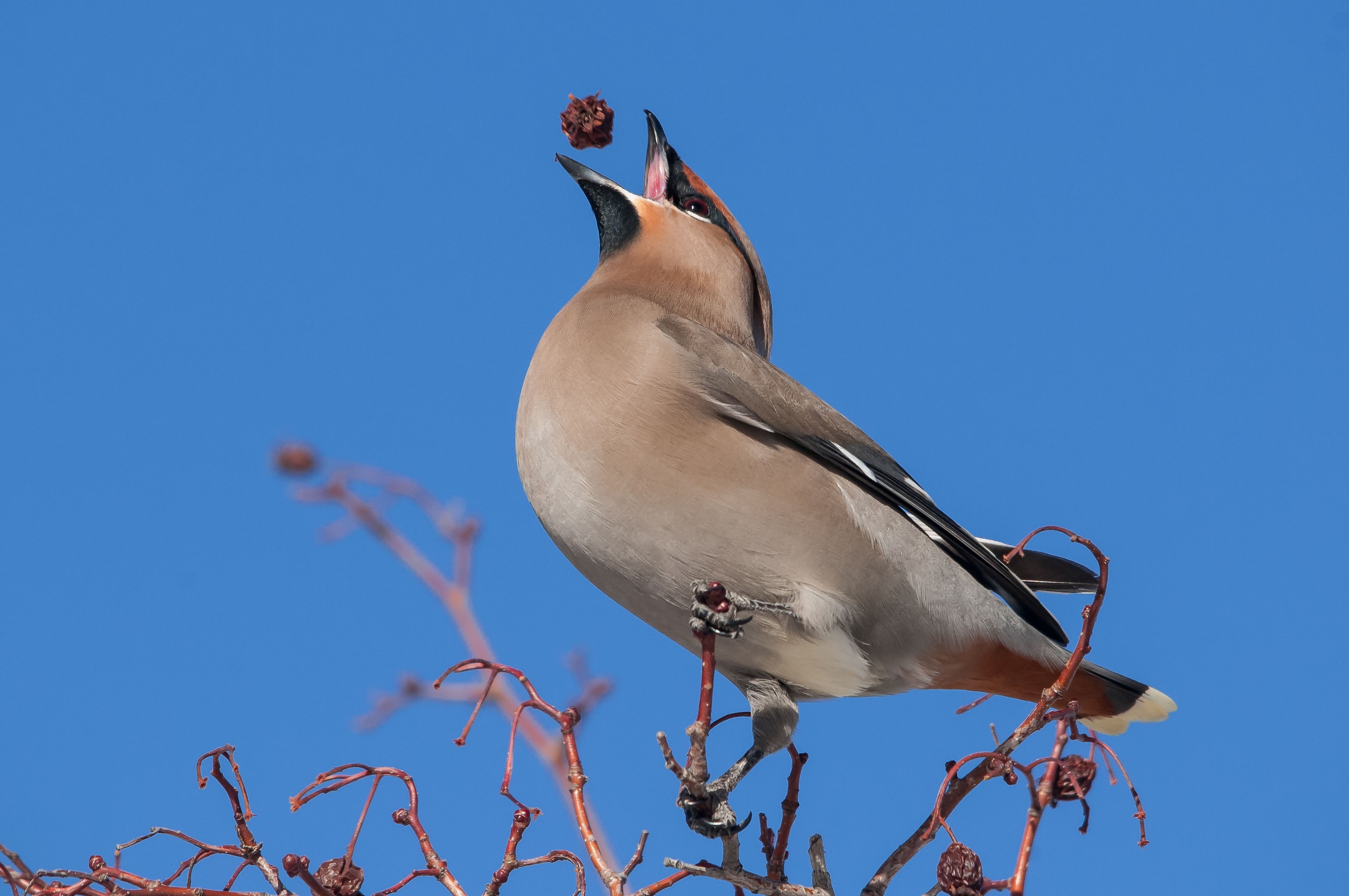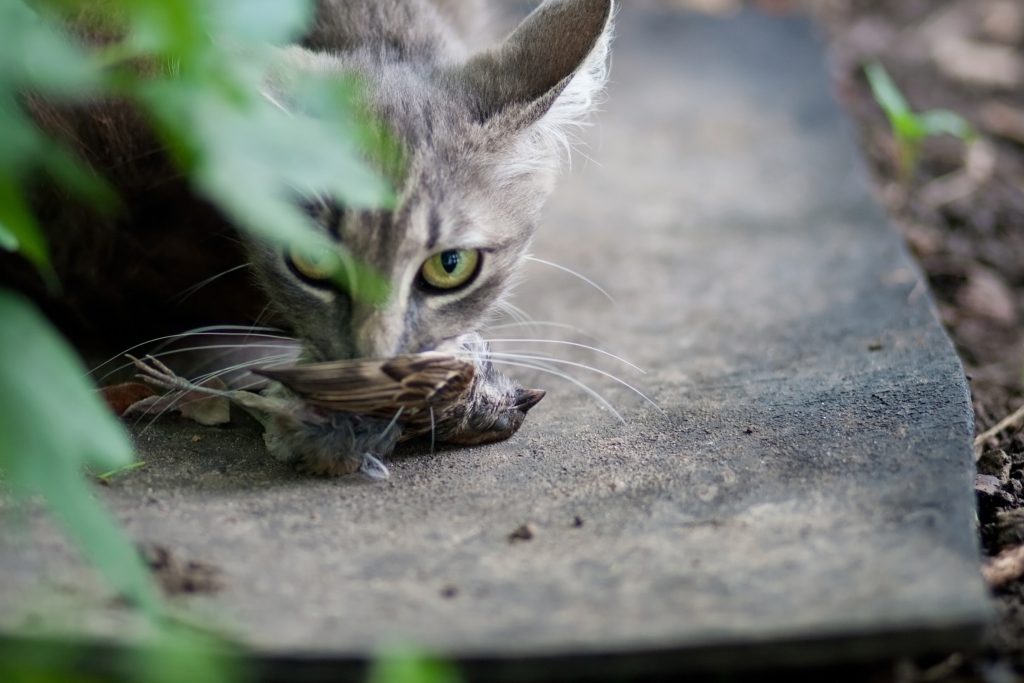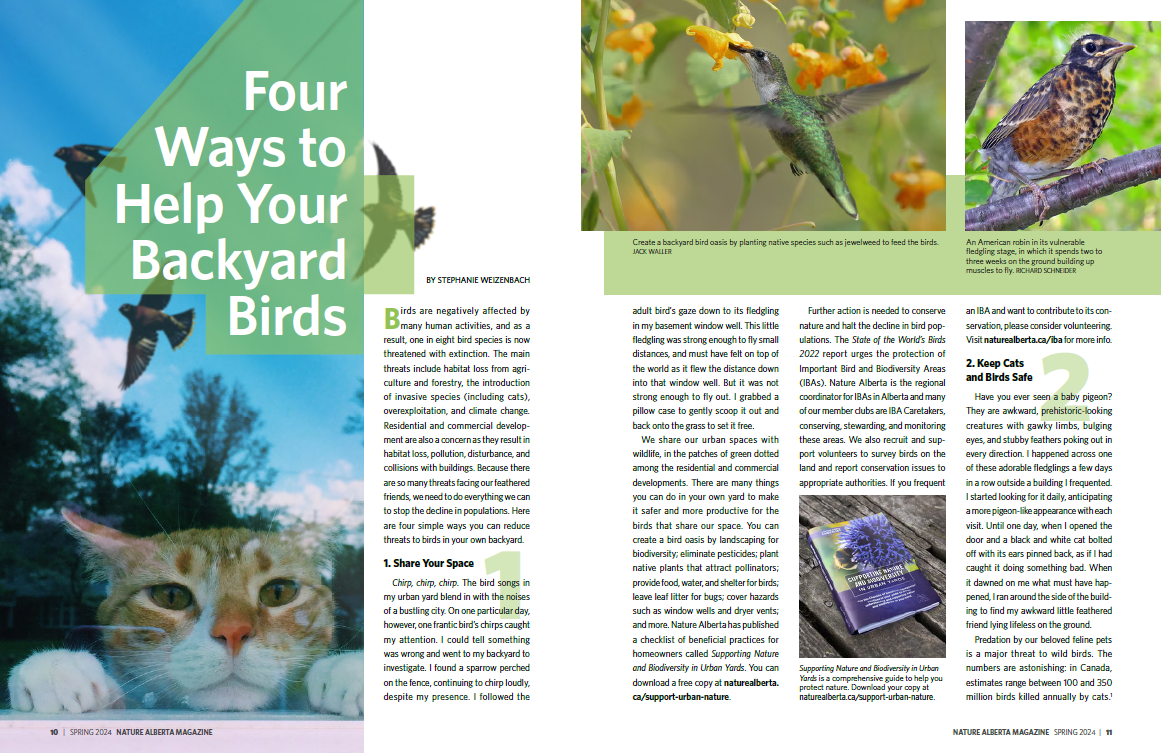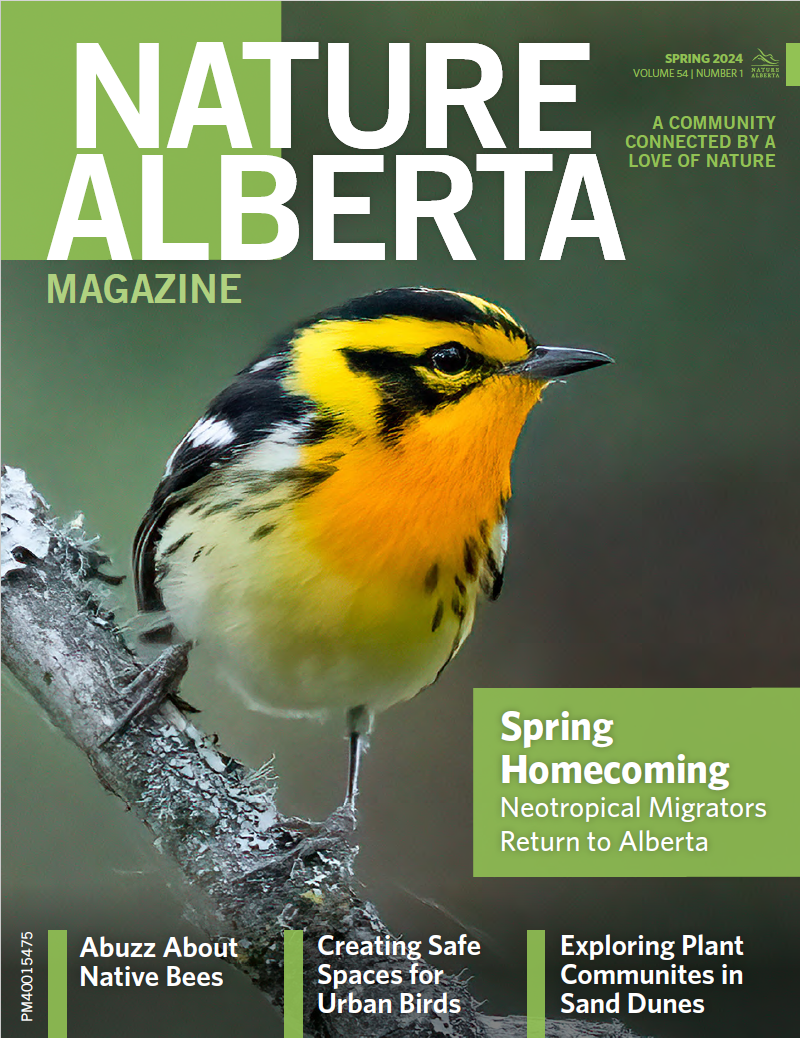Four Ways to Help Your Backyard Birds
22 April 2024

BY STEPHANIE WEIZENBACH
Birds are negatively affected by many human activities, and as a result, one in eight bird species is now threatened with extinction. The main threats include habitat loss from agriculture and forestry, the introduction of invasive species (including cats), overexploitation, and climate change. Residential and commercial development are also a concern as they result in habitat loss, pollution, disturbance, and collisions with buildings. Because there are so many threats facing our feathered friends, we need to do everything we can to stop the decline in populations. Here are four simple ways you can reduce threats to birds in your own backyard.
- Share Your Space
Chirp, chirp, chirp. The bird songs in my urban yard blend in with the noises of a bustling city. On one particular day, however, one frantic bird’s chirps caught my attention. I could tell something was wrong and went to my backyard to investigate. I found a sparrow perched on the fence, continuing to chirp loudly, despite my presence. I followed the adult bird’s gaze down to its fledgling in my basement window well. This little fledgling was strong enough to fly small distances, and must have felt on top of the world as it flew the distance down into that window well. But it was not strong enough to fly out. I grabbed a pillow case to gently scoop it out and back onto the grass to set it free.
We share our urban spaces with wildlife, in the patches of green dotted among the residential and commercial developments. There are many things you can do in your own yard to make it safer and more productive for the birds that share our space. You can create a bird oasis by landscaping for biodiversity; eliminate pesticides; plant native plants that attract pollinators; provide food, water, and shelter for birds; leave leaf litter for bugs; cover hazards such as window wells and dryer vents; and more. Nature Alberta has published a checklist of beneficial practices for homeowners called Supporting Nature and Biodiversity in Urban Yards. You can download a free copy at naturealberta.ca/support-urban-nature.
Further action is needed to conserve nature and halt the decline in bird populations. The State of the World’s Birds 2022 report urges the protection of Important Bird and Biodiversity Areas (IBAs). Nature Alberta is the regional coordinator for IBAs in Alberta and many of our member clubs are IBA Caretakers, conserving, stewarding, and monitoring these areas. We also recruit and support volunteers to survey birds on the land and report conservation issues to appropriate authorities. If you frequent an IBA and want to contribute to its conservation, please consider volunteering. Visit naturealberta.ca/iba for more info.
- Keep Cats and Birds Safe
Have you ever seen a baby pigeon? They are awkward, prehistoric-looking creatures with gawky limbs, bulging eyes, and stubby feathers poking out in every direction. I happened across one of these adorable fledglings a few days in a row outside a building I frequented. I started looking for it daily, anticipating a more pigeon-like appearance with each visit. Until one day, when I opened the door and a black and white cat bolted off with its ears pinned back, as if I had caught it doing something bad. When it dawned on me what must have happened, I ran around the side of the building to find my awkward little feathered friend lying lifeless on the ground.
Predation by our beloved feline pets is a major threat to wild birds. The numbers are astonishing: in Canada, estimates range between 100 and 350 million birds killed annually by cats. Cats have a strong hunting instinct and will kill birds even when well fed. Even if your cat doesn’t bring home birds, it is likely still hunting and killing birds while roaming the neighbourhood. Fledgling birds that are learning to fly in the middle of summer are most vulnerable. And even if the bird is lucky enough to escape a cat’s jaws, the bird can die from an infection left by the cat’s saliva in the puncture wounds.
Keeping your cats indoors is safest for birds and for cats. Cats that are free to roam outside are at risk of bringing home parasites; becoming prey to coyotes, foxes, owls, and hawks; getting hit by a vehicle; and sustaining injuries from fights with other animals. They also increase feral cat populations when not spayed or neutered. The estimated lifespan of an outdoor cat is only 3–5 years whereas an indoor cat can live to be 12–15 years old.
Many people use catios: fenced-in outdoor enclosures where cats can spend time outdoors without being able to leave the yard. You can also help replace the cat’s instinctive hunting activities with stimulating toys and food puzzles. Keeping your cats living happily indoors and relaxing in catios will reduce their threat to our backyard birds while extending the cat’s life expectancy!

Cats kill as many as 350 million birds annually in Canada.
- Make Windows Visible to Birds
One day, as I opened the curtains of a large office window, I heard a loud thump as a juvenile robin hit the window. Fortunately, I was at work at a wildlife rehabilitation centre. I placed the stunned bird in a box lined with paper towel and kept it in a dark, quiet place for a couple of hours to recover. I later took the box back outside and opened it up and the bird flew away. Luckily, the robin hit the window at a slow speed and only stunned itself. In many other cases, songbirds brought to the centre have had broken bones or ruptured air sacs after hitting windows, requiring six weeks to recover.
An estimated 25 million birds are killed in Canada annually by colliding with windows.2 There are many variables that contribute to window strikes, including the reflection of trees and sky, clear flight paths in or through a building, cleanliness of the windows, angle of the light, and even the placement of food and water sources in our backyards. When we turn our backyard into a bird oasis with native plants, bird feeders, houses, and baths, we provide habitat that was previously lost through development. But now there is habitat with large picture windows in the birds’ backyard.
Studies have shown that placing your bird feeders or baths between 1 and 10 metres from your windows can increase the threat of a bird hitting the window. The ideal placement of these resources is within 1 metre of windows so that if a bird does fly into the window, they are less likely to be injured. Alternatively, placing bird feeders and baths more than 10 metres from windows reduces the occurrence of birds hitting the structure’s windows.
You can reduce collisions with windows by making them more visible to birds. You can hang string or ribbon in front of the window, or draw designs on the window with washable tempera paint or even a bar of soap! You can also apply decorative or frosted window films to protect the birds in style. Bird stores carry many products such as decals, window markers, tape, and a relatively new product that applies rows of white dots on the window. If you have a backyard bird oasis and birds are regularly hitting your windows, follow FLAP Canada’s recommendations to install high-contrast, dense patterns to the outside of the window, leaving gaps no larger than 5 cm by 5 cm.
There are even affordable ways to build new buildings to reduce the risk of collisions for birds, using a national CSA standard for bird-friendly building design. Write to your city council to urge your municipal government to adopt and implement the standard to make all new buildings bird friendly!
- Reduce Your Light Pollution
Light pollution – the alteration of outdoor light levels – diminishes the dark sky with an orange glow above our cities. A light pollution map created in 2018 placed Calgary and Edmonton as the world’s fifth and sixth brightest cities (compared to the global urban average), respectively, leading the world in light pollution. Light pollution has numerous harmful effects on wild species, including birds. Many animals and plants rely on the natural cycle of light and dark to cue critical behaviours, such as feeding, sleep, reproduction, and predator avoidance. Migrating birds use the moon, stars, and setting sun to navigate. Unfortunately, these birds are drawn toward light-polluted areas, veering off course to enter large cities during migration. This increases the flock’s chance of colliding with buildings.
You can help reduce light pollution around your own home. Efficient use of lighting increases visibility on the ground, reduces power consumption, and produces less greenhouse gas emissions. To reduce your light levels, completely shield outdoor lights to direct all light towards the ground, where it is needed most. Directing all of the light towards the ground allows you to select a lower-wattage bulb for lighting, which saves energy as well. Installing timers or motion sensors also reduces light pollution by only using the light when needed. Information on a wide variety of efficient, dark-sky approved lighting products is available at darksky.org.
Interested in advancing bird conservation in urban areas? Bird Friendly teams are popping up all over the province! Find out how to get involved with Bird Friendly Edmonton at birdfriendlyedmonton.org and Bird Friendly Calgary at birdfriendlycalgary.ca.
Stephanie Weizenbach studied environmental and conservation sciences at the University of Alberta with a major in conservation biology. She currently serves as Nature Alberta’s Executive Director and contributes to bird conservation on the Bird Friendly Edmonton Team.
Read the Original Article for this Post
For a richer reading experience, view this article in the professionally designed online magazine with all images and graphs in place.
This article originally ran in the Spring 2024 issue of Nature Alberta Magazine (Vol. 54 | No. 1).


